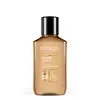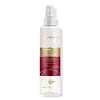What's inside
What's inside
 Key Ingredients
Key Ingredients

No key ingredients
 Benefits
Benefits

 Concerns
Concerns

 Ingredients Side-by-side
Ingredients Side-by-side

Water
Skin ConditioningCyclopentasiloxane
EmollientDimethicone
EmollientC12-15 Alkyl Benzoate
AntimicrobialCinnamidopropyltrimonium Chloride
PEG/PPG-15/15 Dimethicone
EmulsifyingKeratin
Skin ConditioningHydrolyzed Keratin
HumectantLaurdimonium Hydroxypropyl Hydrolyzed Keratin
Skin ConditioningAvena Sativa Peptide
Skin ConditioningArginine Hcl
Skin ConditioningArginine
MaskingRosa Canina Fruit Oil
EmollientArgania Spinosa Kernel Oil
EmollientSchinziophyton Rautanenii Kernel Oil
EmollientHydrolyzed Keratin Pg-Propylmethylsilanediol
Skin ConditioningAllantoin
Skin ConditioningAloe Barbadensis Leaf Juice
Skin ConditioningPhosphatidylcholine
EmulsifyingButyl Methoxydibenzoylmethane
UV AbsorberOenothera Biennis Oil
EmollientCocodimonium Hydroxypropyl Hydrolyzed Keratin
Skin ConditioningPsidium Guajava Fruit Extract
AstringentAleurites Moluccanus Seed Oil
Skin ConditioningThioctic Acid
AntioxidantGlycolipids
Skin ConditioningTocopheryl Acetate
AntioxidantHydrogenated Castor Oil/Sebacic Acid Copolymer
EmollientDipropylene Glycol
HumectantPolysorbate 20
EmulsifyingC10-40 Isoalkylamidopropylethyldimonium Ethosulfate
PEG-40 Hydrogenated Castor Oil
EmulsifyingCetrimonium Chloride
AntimicrobialCocamidopropyl Betaine
CleansingPolyquaternium-11
Sodium Hyaluronate
HumectantCitric Acid
BufferingTetrasodium EDTA
Polysilicone-19
Glycerin
HumectantPolyquaternium-55
Sodium Ascorbyl Phosphate
AntioxidantAminomethyl Propanol
BufferingCaprylhydroxamic Acid
1,2-Hexanediol
Skin ConditioningPropanediol
SolventPhenoxyethanol
PreservativeSodium Benzoate
MaskingBenzyl Alcohol
PerfumingBenzoic Acid
MaskingHydroxycitronellal
PerfumingLinalool
PerfumingAlpha-Isomethyl Ionone
PerfumingCoumarin
PerfumingCinnamyl Alcohol
PerfumingParfum
MaskingWater, Cyclopentasiloxane, Dimethicone, C12-15 Alkyl Benzoate, Cinnamidopropyltrimonium Chloride, PEG/PPG-15/15 Dimethicone, Keratin, Hydrolyzed Keratin, Laurdimonium Hydroxypropyl Hydrolyzed Keratin, Avena Sativa Peptide, Arginine Hcl, Arginine, Rosa Canina Fruit Oil, Argania Spinosa Kernel Oil, Schinziophyton Rautanenii Kernel Oil, Hydrolyzed Keratin Pg-Propylmethylsilanediol, Allantoin, Aloe Barbadensis Leaf Juice, Phosphatidylcholine, Butyl Methoxydibenzoylmethane, Oenothera Biennis Oil, Cocodimonium Hydroxypropyl Hydrolyzed Keratin, Psidium Guajava Fruit Extract, Aleurites Moluccanus Seed Oil, Thioctic Acid, Glycolipids, Tocopheryl Acetate, Hydrogenated Castor Oil/Sebacic Acid Copolymer, Dipropylene Glycol, Polysorbate 20, C10-40 Isoalkylamidopropylethyldimonium Ethosulfate, PEG-40 Hydrogenated Castor Oil, Cetrimonium Chloride, Cocamidopropyl Betaine, Polyquaternium-11, Sodium Hyaluronate, Citric Acid, Tetrasodium EDTA, Polysilicone-19, Glycerin, Polyquaternium-55, Sodium Ascorbyl Phosphate, Aminomethyl Propanol, Caprylhydroxamic Acid, 1,2-Hexanediol, Propanediol, Phenoxyethanol, Sodium Benzoate, Benzyl Alcohol, Benzoic Acid, Hydroxycitronellal, Linalool, Alpha-Isomethyl Ionone, Coumarin, Cinnamyl Alcohol, Parfum
Alternatives
Ingredients Explained
These ingredients are found in both products.
Ingredients higher up in an ingredient list are typically present in a larger amount.
You may know this ingredient as argan oil. Argan Oil has antioxidant, hydrating, and soothing properties.
Studies have shown argan oil can help fight again radical damage from the sun. This makes it effective at preventing hyperpigmentation.
Large amounts of vitamin E found in argan oil helps the skin retain water. Argan oil also contains fatty acids such as linoleic acid, oleic acid, and palmitic acid. It is also a good source of lipids.
Another benefit of argan oil is skin-soothing. It can help reduce inflammation-related skin symptoms.
Argan Oil is effective at regulating sebum production in pores. This can make it effective at treating hormonal acne.
Traditionally, argan oil was used for its antibacterial and antifungal properties. However, argan oil contains fatty acids that may make it not fungal-acne safe.
Argan Trees are native to Morocco.
Learn more about Argania Spinosa Kernel OilBenzyl Alcohol is most commonly used as a preservative. It also has a subtle, sweet smell. Small amounts of Benzyl Alcohol is not irritating and safe to use in skincare products. Most Benzyl Alcohol is derived from fruits such as apricots.
Benzyl Alcohol has both antibacterial and antioxidant properties. These properties help lengthen the shelf life of products. Benzyl Alcohol is a solvent and helps dissolve other ingredients. It can also improve the texture and spreadability.
Alcohol comes in many different forms. Different types of alcohol will have different effects on skin. This ingredient is an astringent alcohol.
Using high concentrations of these alcohols are drying on the skin. They may strip away your skin's natural oils and even damage your skin barrier. Astringent alcohols may also irritate skin.
Other types of astringent alcohols include:
According to the National Rosacea Society based in the US, you should be mindful of products with these alcohols in the top half of ingredients.
Any type of sanitizing product will have high amounts of alcohol to help kill bacteria and viruses.
Learn more about Benzyl AlcoholCoumarins are a group of substances found naturally in plants. There are over 1300 types of coumarins identified. It has a natural vanilla scent.
Coumarin is an identified EU known allergy, meaning it may cause an allergic reaction when applied to the skin.
In many countries, coumarin is banned as a food additive. However, it can be found in soaps, tobacco products, and some alcohol drinks.
Plants use coumarins as a chemical defense. Some plants that have coumarins include lavender, tonka beans, and yellow clovers.
Learn more about CoumarinCyclopentasiloxane, or D5, is a silicone used to improve texture of products and trap moisture.
D5 is considered lightweight and volatile. Volatile means it evaporates quickly after application. Once evaporated, D5 leaves a thin barrier that helps keep skin hydrated.
It is also an emollient. Emollients help soften the skin and prevent water loss. Silicones create a silky texture in products. D5 helps other ingredients become more spreadable.
Studies show D5 is safe to use in skincare products. We recommend speaking with a skincare professional if you have concerns.
Learn more about CyclopentasiloxaneDimethicone is a type of synthetic silicone created from natural materials such as quartz.
What it does:
Dimethicone comes in different viscosities:
Depending on the viscosity, dimethicone has different properties.
Ingredients lists don't always show which type is used, so we recommend reaching out to the brand if you have questions about the viscosity.
This ingredient is unlikely to cause irritation because it does not get absorbed into skin. However, people with silicone allergies should be careful about using this ingredient.
Note: Dimethicone may contribute to pilling. This is because it is not oil or water soluble, so pilling may occur when layered with products. When mixed with heavy oils in a formula, the outcome is also quite greasy.
Learn more about DimethiconeLinalool is a fragrance and helps add scent to products. It's derived from common plants such as cinnamon, mint, citrus, and lavender.
Like Limonene, this ingredient oxidizes when exposed to air. Oxidized linalool can cause allergies and skin sensitivity.
This ingredient has a scent that is floral, spicy tropical, and citrus-like.
Learn more about LinaloolParfum is a catch-all term for an ingredient or more that is used to give a scent to products.
Also called "fragrance", this ingredient can be a blend of hundreds of chemicals or plant oils. This means every product with "fragrance" or "parfum" in the ingredients list is a different mixture.
For instance, Habanolide is a proprietary trade name for a specific aroma chemical. When used as a fragrance ingredient in cosmetics, most aroma chemicals fall under the broad labeling category of “FRAGRANCE” or “PARFUM” according to EU and US regulations.
The term 'parfum' or 'fragrance' is not regulated in many countries. In many cases, it is up to the brand to define this term.
For instance, many brands choose to label themselves as "fragrance-free" because they are not using synthetic fragrances. However, their products may still contain ingredients such as essential oils that are considered a fragrance by INCI standards.
One example is Calendula flower extract. Calendula is an essential oil that still imparts a scent or 'fragrance'.
Depending on the blend, the ingredients in the mixture can cause allergies and sensitivities on the skin. Some ingredients that are known EU allergens include linalool and citronellol.
Parfum can also be used to mask or cover an unpleasant scent.
The bottom line is: not all fragrances/parfum/ingredients are created equally. If you are worried about fragrances, we recommend taking a closer look at an ingredient. And of course, we always recommend speaking with a professional.
Learn more about Parfum